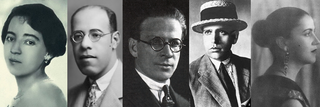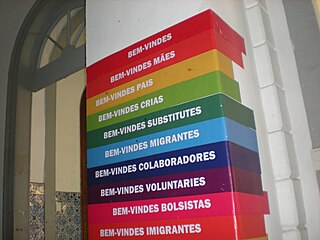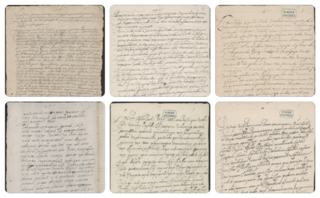The Tupi people, a subdivision of the Tupi-Guarani linguistic families, were one of the largest groups of indigenous peoples in Brazil before its colonization. Scholars believe that while they first settled in the Amazon rainforest, from about 2,900 years ago the Tupi started to migrate southward and gradually occupied the Atlantic coast of Southeast Brazil.
Anthropophagy is the custom and practice of eating the flesh or internal organs of human beings. It may refer to:

Daniela Mercury is a Brazilian singer, songwriter, dancer, and producer. In her solo career, Mercury has sold over 11 million records worldwide, and had 24 Top 10 singles in the country, with 14 of them reached No. 1. Winner of a Latin Grammy for her album Balé Mulato – Ao Vivo, she also received six Brazilian Music Award, an APCA award, three Multishow Brazilian Music Awards and two awards at VMB: Best Music Video and Photography.

Tarsila de Aguiar do Amaral was a Brazilian painter, draftswoman, and translator. She is considered one of the leading Latin American modernist artists, and is regarded as the painter who best achieved Brazilian aspirations for nationalistic expression in a modern style. As a member of the Grupo dos Cinco, Tarsila is also considered a major influence in the modern art movement in Brazil, alongside Anita Malfatti, Menotti Del Picchia, Mário de Andrade, and Oswald de Andrade. She was instrumental in the formation of the aesthetic movement, Antropofagia (1928–1929); in fact, Tarsila was the one with her celebrated painting, Abaporu, who inspired Oswald de Andrade's famous Manifesto Antropófago.

Macunaíma is a 1928 novel by Brazilian writer Mário de Andrade. It is one of the founding texts of Brazilian modernism. Macunaíma was published six years after the "Semana de Arte Moderna", which marked the beginning of the Brazilian modernism movement.

José Oswald de Souza Andrade was a Brazilian poet, novelist and cultural critic. He was born in, spent most of his life in, and died in São Paulo.

The Modern Art Week was an arts festival in São Paulo, Brazil, that ran from February 10 to February 17, 1922. Historically, the Week marked the start of Brazilian Modernism; though a number of individual Brazilian artists were doing modernist work before the week, it coalesced and defined the movement and introduced it to Brazilian society at large.
The Anthropophagic Manifesto, also variously translated as the Cannibal Manifesto or the Cannibalist Manifesto, was published in 1928 by the Brazilian poet and polemicist Oswald de Andrade, a key figure in the cultural movement of Brazilian Modernism and contributor to the publication Revista de Antropofagia. It was inspired by "Abaporu," a painting by Tarsila do Amaral, modernist artist and wife of Oswald de Andrade. The essay was translated to English in 1991 by Leslie Bary;

The creation of art in the geographic area now known as Brazil begins with the earliest records of its human habitation. The original inhabitants of the land, pre-Columbian Indigenous or Natives peoples, produced various forms of art; specific cultures like the Marajoara left sophisticated painted pottery. This area was colonized by Portugal in the 16th century and given the modern name of Brazil. Brazilian art is most commonly used as an umbrella term for art created in this region post Portuguese colonization.
Adriana Varejão is a Brazilian artist. She works in various disciplines including painting, drawing, sculpture, installation and photography. She was an artist-in-resident at the Isabella Stewart Gardner Museum in 2004. Varejão lives and works in Rio de Janeiro.

Abaporu is an oil painting on canvas by Brazilian painter Tarsila do Amaral. It was painted as a birthday gift to writer Oswald de Andrade, who was her husband at the time.
Patrícia Carlos de Andrade is a Brazilian economist, daughter of the journalist Evandro Carlos de Andrade. She was also married to economist Beny Parnes, with whom she had three children. In March 2005, she founded the Institute of National Reality Studies, which became the Instituto Millenium in April 2006.

Patrícia Rehder Galvão, known by her pseudonym Pagu was a Brazilian writer, poet, playwright, journalist, and translator who had a large role in the Brazilian Modernist movement. Pagu was also politically active, being associated to the Brazilian Communist Party during the 1930 decade.
Sander Henrique Bortolotto, simply known as Sander, is a Brazilian professional footballer who plays as a left back for Goiás.

The Grupo dos Cinco were a group of influential painters and writers associated with Brazilian Modernism. They worked together from approximately 1922–1929, although their individual work as artists and poets existed prior to this and continued after their collaboration ended. Grupo dos Cinco included Anita Malfatti, Tarsila do Amaral, Menotti Del Picchia, Oswald de Andrade and Mario de Andrade. While Malfatti and Amaral were painters, their three male counterparts were poets and writers. Grupo dos Cinco are known for their pivotal role in seeking what it is to be Brazilian as well as their work and involvement with the Semana de Arte Moderna, although Amaral did not participate. As a group, they developed ideas and manifestos that would inspire future generations of Brazilian artists such as the Pau-Brasil poetry manifesto and Antropofagia movement.

Juventus-Mooca is a train station on CPTM's Line 10-Turquoise. It's located in the city of São Paulo.

Gender-neutral language in Portuguese is a recent strand of demands for greater gender equality and social inclusion between men, women and non-binary individuals. It can be divided into inclusive or non-sexist language, and non-binary or neuter language or neolanguage. Inclusive language aims to use existing words to include all genders, while neuter language uses new or modified words to accomplish this.

Camarão Indians' letters, also known as Tupi letters from Camarão Indians, are a series of six letters exchanged between Potiguara Indians during 1645, in the first half of the 17th century, in the context of the Dutch invasions of Brazil. They are the only known texts written by Brazilian Indians until the Independence of Brazil. The Camarão Indians' letters are also the only record of Old Tupi writing in Colonial Brazil. Today, the correspondence is stored in the archives of the Royal Library of the Netherlands, and has been preserved there for almost 400 years.

Modernism in Brazil was a broad cultural movement that strongly affected the art scene and Brazilian society in the first half of the 20th century, especially in the fields of literature and the plastic arts. It was inspired by the cultural and artistic trends launched in Europe in the period before the World War I such as Cubism, Futurism, Expressionism and Surrealism. These new modern languages brought by the European artistic and literary movements were gradually assimilated into the Brazilian artistic context, but with elements of the country's culture, as there was a need to valorize the national identity.

The anthropophagic movement was a Brazilian artistic manifestation of the 1920s founded and theorized by the poet Oswald de Andrade and the painter Tarsila do Amaral.













